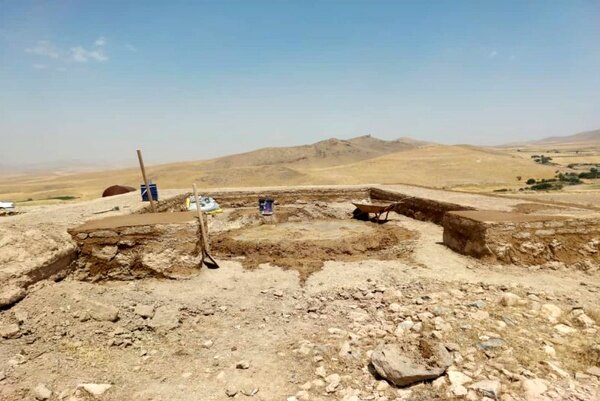Archaeologists finish survey on previous capital of Mannaean kingdom

TEHRAN – Archaeologists have recently completed a month-long field survey on the ancient Qalaichi site, which was once the capital of the Mannaean kingdom.
Archaeologists carried out projects to safeguard previously-found ruined structures on the one hand, and projects to unearth further architectural heritage, on the other hand, the tourism chief of West Azarbaijan has said.
The survey was conducted under the supervision of the cultural heritage and tourism directorate of the northwestern province, Jalil Jabari said.
Qalaichi is famed for its glazed bricks, some of which had been looted and smuggled out of Iran about four decades ago, and being returned home with the aid of Swiss officials in December 2020.
In the 1970s, a farmer plowing at Qalaichi came across a decorated brick, probably from the columned hall of a citadel. This discovery led to extremely damaging illegal excavations, partly using a bulldozer. Eventually, in 1985, there was an official rescue excavation, but this was quickly abandoned because of an intensification of the Iran-Iraq War. There were then 14 more years of illegal digging until 1999 when there was another official excavation. But by this time only small fragments of broken bricks were found.
Situated about nine air km northwest of Bukan, Qalaichi (or Ghalay-chi) is an ancient settlement so far yielded a large number of glazed objects. Some of which are monochrome and the others show complex compositions. The glazed objects from the regular excavations were curated in Urmia Museum and Tehran National Museum.
The artifacts are connected to the Mannai civilization, which once flourished in northwestern Iran in the 1st millennium BC. Mannai, also spelled Manna, was an ancient country surrounded by three major powers of the time namely Assyria, Urartu, and Media.
According to the Encyclopedia Britannica, the Mannaeans are first recorded in the annals of the Assyrian king Shalmaneser III (reigned 858–824 BC) and are last mentioned in Urartu by Rusa II (reigned 685–645 BC) and in Assyria by Esarhaddon (reigned 680–669 BC). With the intrusion of the Scythians and the rise of the Medes in the 7th century, the Manneans lost their identity and were subsumed under the term Medes.
The first well-documented evidence of human habitation in the Iranian plateau was found from several excavated cave and rock-shelter sites, located mainly in the Zagros Mountains of western Iran and dated to Middle Paleolithic or Mousterian times (c. 100,000 BC).
From the Caspian in the northwest to Baluchistan in the southeast, the Iranian plateau extends for close to 2,000 km. The land encompasses the greater part of Iran, Afghanistan, and Pakistan west of the Indus River containing some 3,700,000 square kilometers. Despite being called a “plateau”, it is far from flat but contains several mountain ranges, the highest peak being Damavand in the Alborz mountain range at 5610 m, and the Dasht-e Loot east of Kerman in Central Iran falling below 300 m.
AM
Leave a Comment